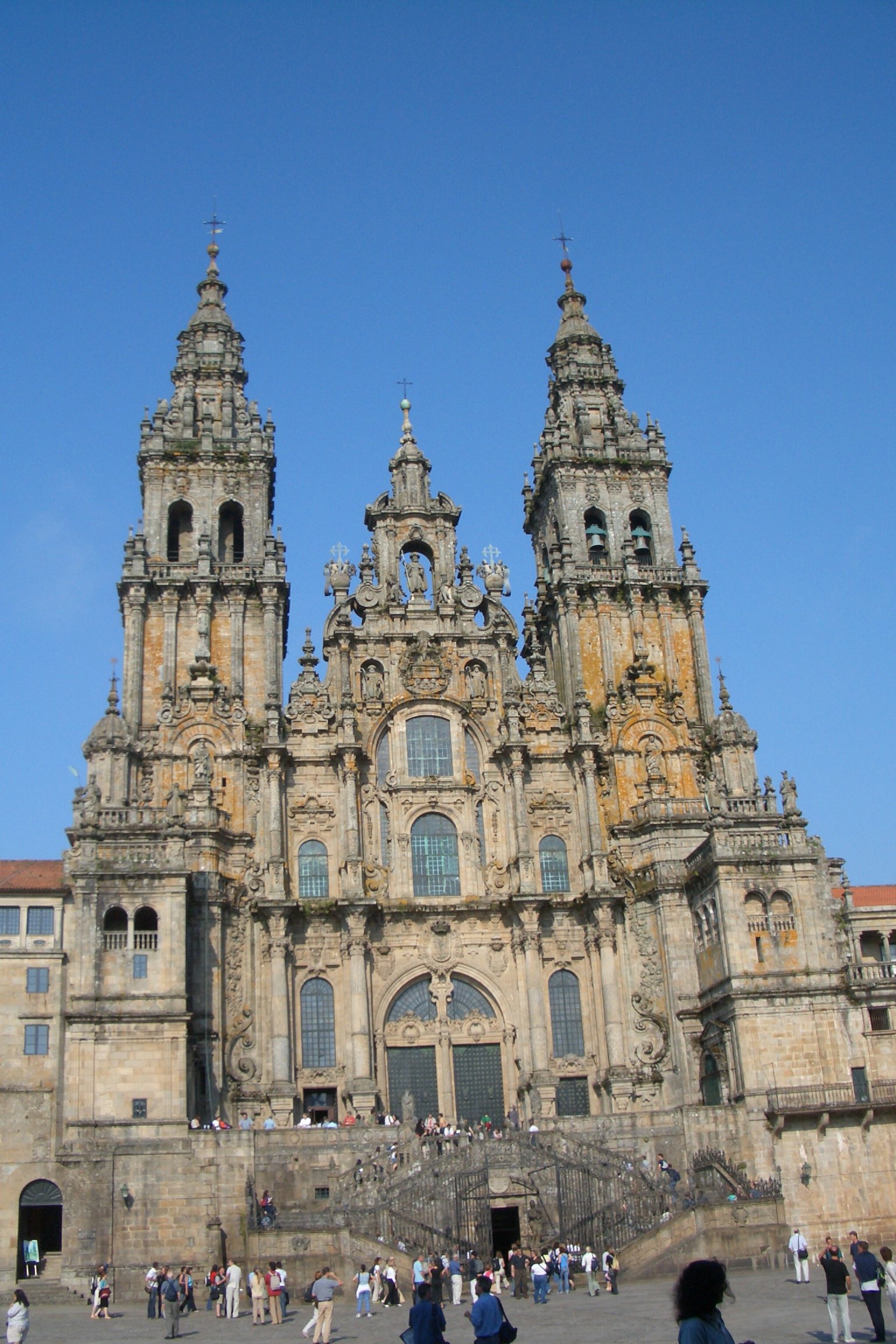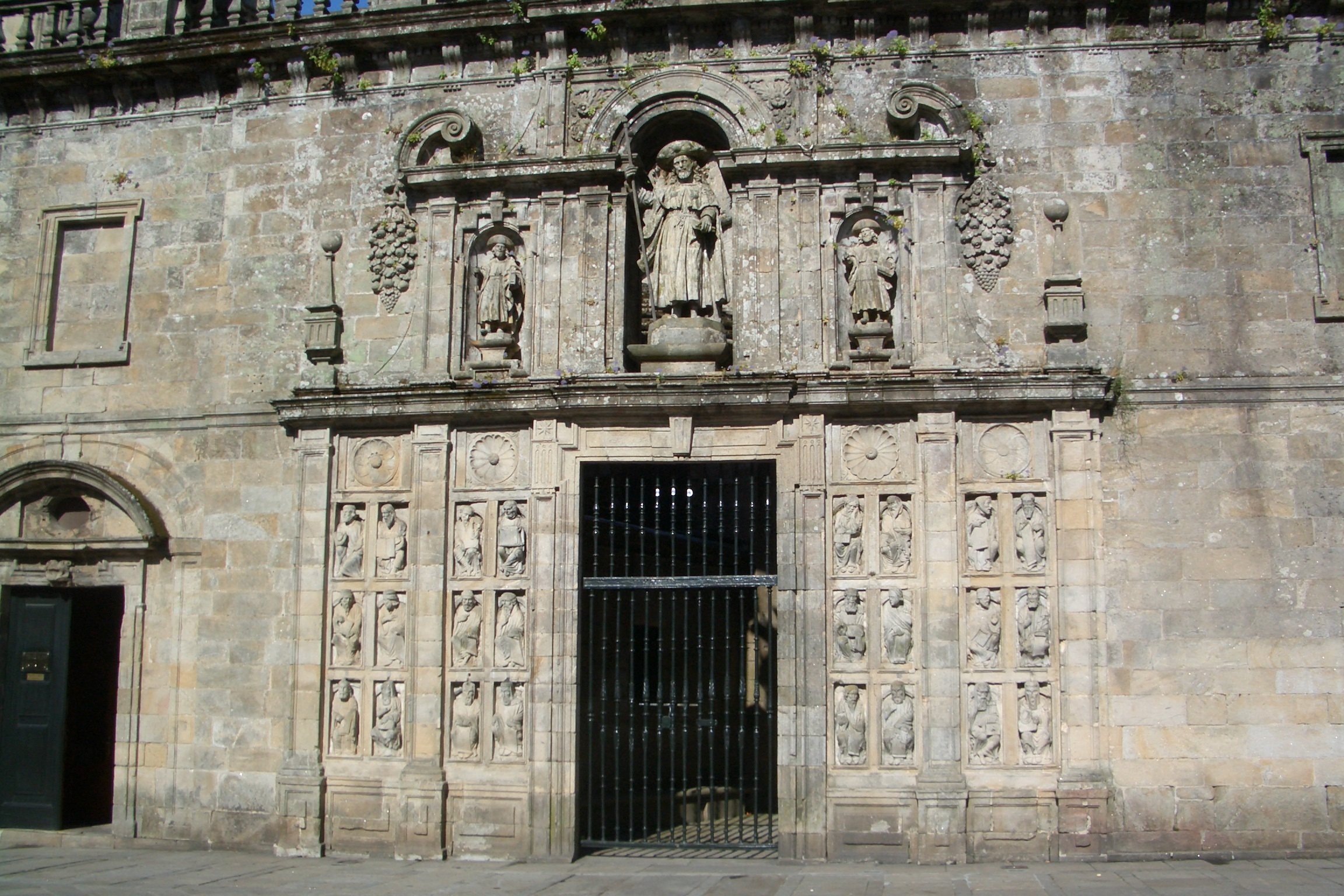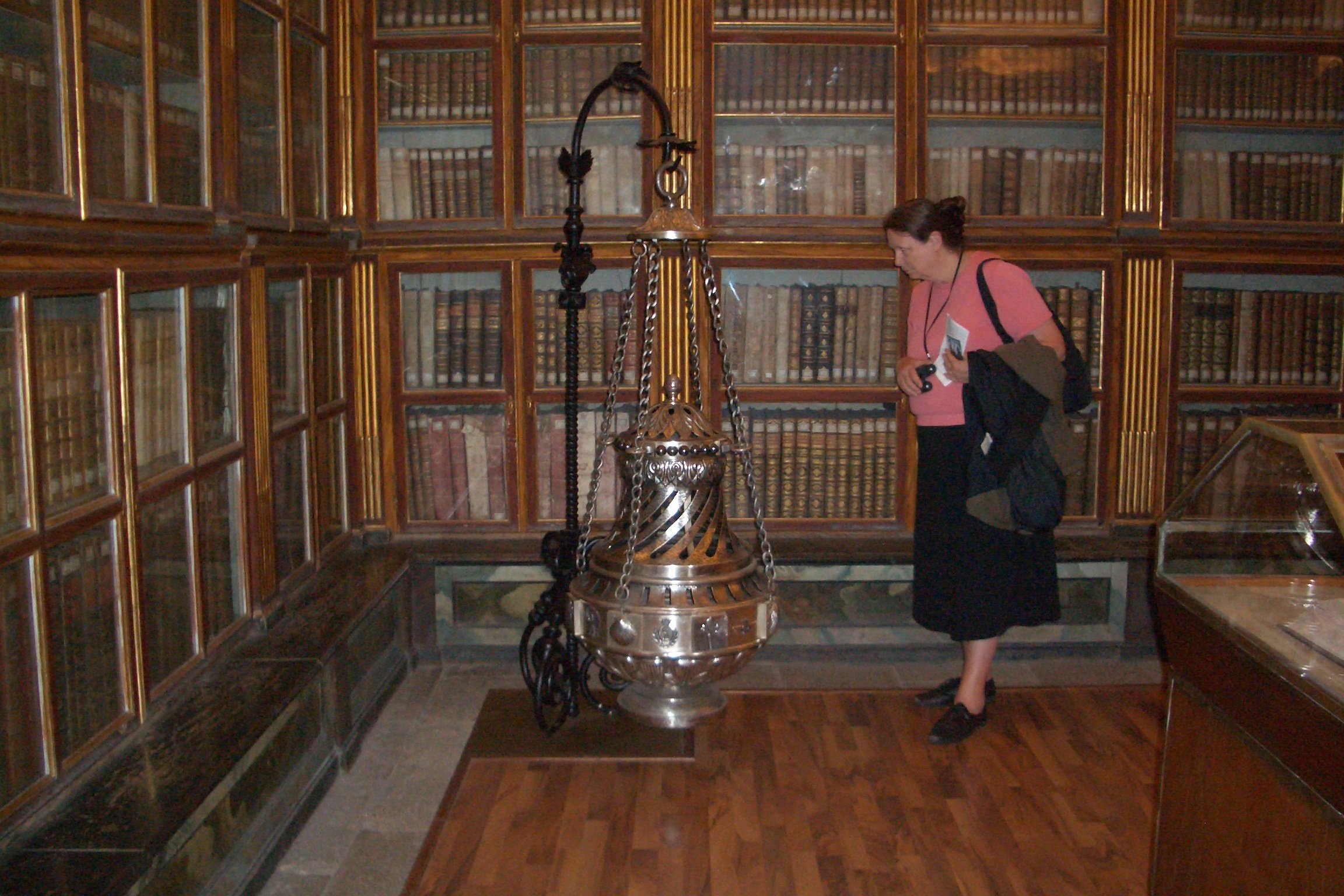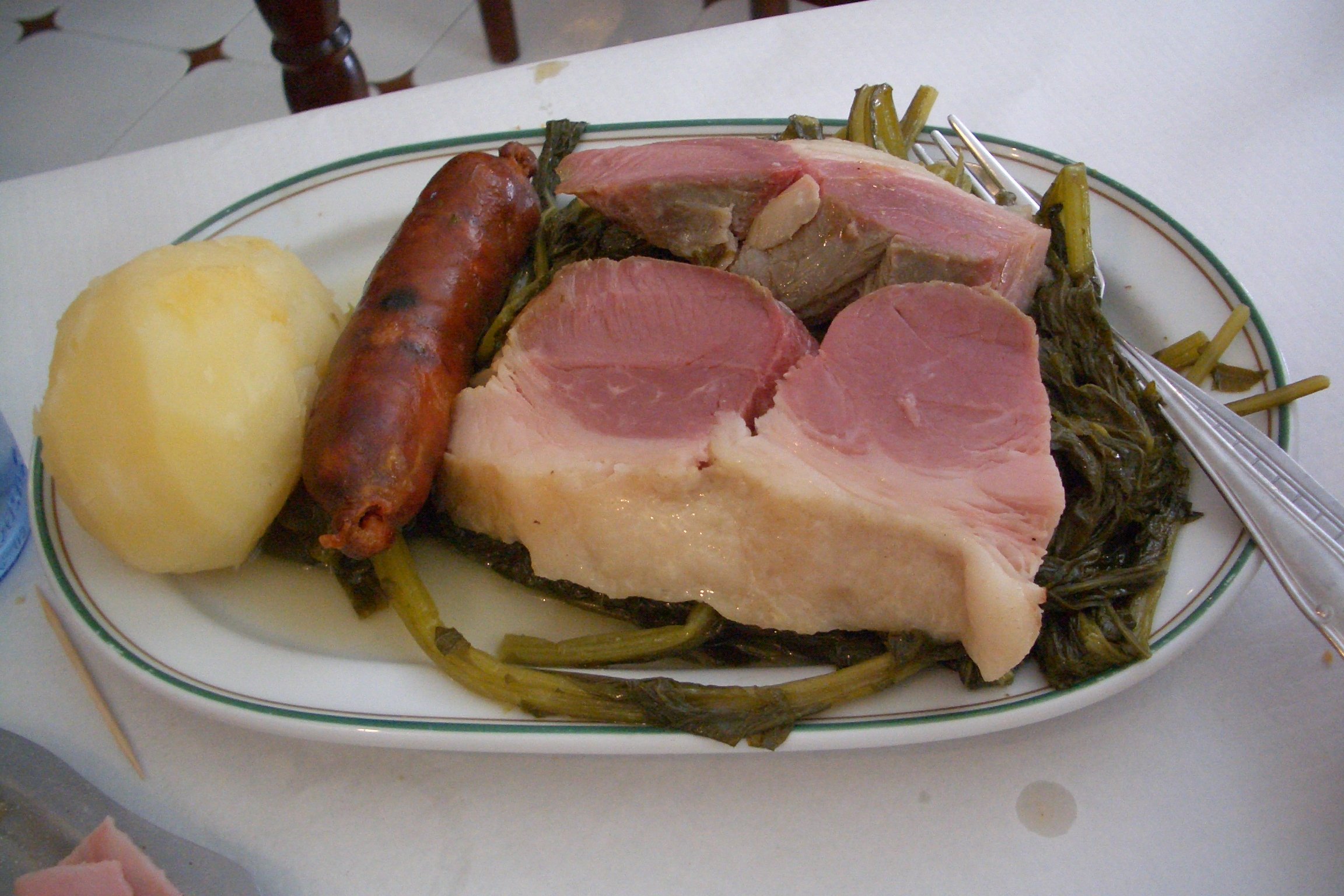Santiago de Compostela
posted 5 July 2005
Written 25 June 2005
During the meetings, I ate the first couple of lunches at our hotel, which offered a terrific deal. Only if you you happened to ride up and down in our elevator did you see the ad, whose Spanish I puzzled out, that said "buffet lunch, 10 euros plus tax and drink, 1:30-4:00 p.m." (the Spanish eat every meal very late by American standards). The photo showed a vast buffet of local specalities. David had a lunch meeting the first day, so I walked over, just at 1:30, to give it a try. Sure enough, there was the buffet, but the room was deserted; I was the only customer. I paused by the unmanned cash register, but the couple of waiters setting out the last of the food ignored me, so I took a table, picked up a plate and assembled a nice sampling of the offerings—two hot soups plus gazpacho, hot grilled vegetables, the potato frittata that appeared on all buffets and menus, ravioli filled with spinach and cheese and napped with light tomato sauce, pasta salad, marinated sardines, ca. 10-item salad bar, bread, peppers stuffed with anchovies, three or four cheeses, carrot salad, stuffed zucchini, and more. A real deal for 10 euros. As I at my sampling, a young waitress came to ask me what I wanted to drink (I had mastered "agua sin gaz," still water), but then she pulled out a pad and launched into a long speech starting with ". . . hake, . . . chicken, . . . filet, . . ." before I lost the thread. I suspected I was being offered a choice for the next course, but I wasn't sure if that was part of the 10 euro deal or what. After some confusion and fetching from the kitchen of a guy with a few words of English (the waitress had none, although she had mastered "thank-you" by the end of the week, and had very little patience with those who didn't speak Spanish and only slightly more with those who did), I established that, yes, I was being offered a choice, so I went for "merluza," hake. The guy went back to the kitchen, and the waitress left to greet a couple who were just arriving (1:50 p.m., and they were still the only other customers). They started the same conversation with the waitress and were getting nowhere (they had the grammar to parse the question but not the food vocabulary to get beyond "chicken"). I intervened, to the waitress's relief; they ordered "chicken" and "filet" (although the waitress seemed to try to convey that it wasn't exactly chicken), and we all sat down to enjoy our appetizer buffet. and introduce ourselves. They turned out to be from Harbor Branch in Fort Pierce, Florida, and knew David. Eventually the second courses came. I got two thin, sizzling hot hake steaks baked in an earthenware dish with asparagus and lemon sauce, she got chicken wings, and he got a thin veal steak. While we ate those, the dessert buffet was assembled—flan, "whiskey cake," Santiago cake, fruit parfaits of some kind, chocolate mousse cake—and about six other customers arrived (all from the ASLO meeting). The whole thing turned out to be included in the 10 euro price!

 At 7 p.m. on Monday, just after the reception on the opening night of the meetings, buses showed up to take all comers to the cathedral for sightseeing in town and optional vespers. We decided to sit through the vespers service, for the experience; I was also curious about this special "Botafumeiro" incense that all the guides, including the ASLO program, kept going on about.
At 7 p.m. on Monday, just after the reception on the opening night of the meetings, buses showed up to take all comers to the cathedral for sightseeing in town and optional vespers. We decided to sit through the vespers service, for the experience; I was also curious about this special "Botafumeiro" incense that all the guides, including the ASLO program, kept going on about.  Turns out it wasn't special incense, it was a special censer, the largest in the world. David described it as "R2D2 sized." It was about 3 feet tall, plus about a foot and a half of chain suspension, and it apparently weighs over 100 lb. (We got to see it up close later, in the cathedral library.) It was carried into the church slung on a pole that two guys carried on their shoulders. In the space in front of the altar, it was fired up, and when it was smoking well, it was tied to a large hempen rope (more than an inch in diameter) that disappeared up into the tower to a complicated pully apparatus a hundred feet overhead. At the other end of the rope, standing in the aisle of thenave, were the two guys who carried it in and four of their friends, each holding onto one of several smaller knotted ropes that formed a sort of cat-o-nine-tails attached to the big one. At the appointed time, the censer was set swinging, sideways, and the guys on the ropes started pulling. The entire, 100-lb., smouldering apparatus was swung higher and higher, into one transept, then into the other, and back again. It was hair-raising! Fortunately, they knew what they were doing—they managed not to hit any of the huge stone pillars or the vaulted ceiling (though they came scarily close), and it didn't fall off the rope (as it apparently has twice in the history of the cathedral) and crush any of the standing-room-only crowd over whose heads it was swinging. They got it swinging almost horizontally in both directions (82 degrees from the vertical, according to the guidebooks), and not just in a semi-circular arc—they let out more rope at the extremes, so that it reached almost to the ends of the transcepts, then pulled it in on the downswing, so that it didn't hit the floor (or the crowd, the presiding priest, or the singing nun) as it passed the center. Apparently they do this routine only about 20 times a year, so we were lucky to witness it.
Turns out it wasn't special incense, it was a special censer, the largest in the world. David described it as "R2D2 sized." It was about 3 feet tall, plus about a foot and a half of chain suspension, and it apparently weighs over 100 lb. (We got to see it up close later, in the cathedral library.) It was carried into the church slung on a pole that two guys carried on their shoulders. In the space in front of the altar, it was fired up, and when it was smoking well, it was tied to a large hempen rope (more than an inch in diameter) that disappeared up into the tower to a complicated pully apparatus a hundred feet overhead. At the other end of the rope, standing in the aisle of thenave, were the two guys who carried it in and four of their friends, each holding onto one of several smaller knotted ropes that formed a sort of cat-o-nine-tails attached to the big one. At the appointed time, the censer was set swinging, sideways, and the guys on the ropes started pulling. The entire, 100-lb., smouldering apparatus was swung higher and higher, into one transept, then into the other, and back again. It was hair-raising! Fortunately, they knew what they were doing—they managed not to hit any of the huge stone pillars or the vaulted ceiling (though they came scarily close), and it didn't fall off the rope (as it apparently has twice in the history of the cathedral) and crush any of the standing-room-only crowd over whose heads it was swinging. They got it swinging almost horizontally in both directions (82 degrees from the vertical, according to the guidebooks), and not just in a semi-circular arc—they let out more rope at the extremes, so that it reached almost to the ends of the transcepts, then pulled it in on the downswing, so that it didn't hit the floor (or the crowd, the presiding priest, or the singing nun) as it passed the center. Apparently they do this routine only about 20 times a year, so we were lucky to witness it.
 After the mass, we walked around the cathedral and the neighborhood, then had supper at a little restaurant in the pedestrian zone that takes up most of the center of town. The meal wasn't such a much, but I got to try the octopus, which is a local speciality. Restaurants display them, cooked, upside down on top of beer mugs, so that the tentacles hang down all around the sides, suckers up. When you order it, they slice up a serving's worth of tentacles grill them briefly with coarse salt and olive oil (and a more or less tasteless red powder—mild paprika?) and serve them on a little wooden plate. Another great local specialty is roasted piquillo peppers; they're green, a little smaller than jalapenos, and quite mild and sweet. Local restaurants roast them whole, again with olive oil and coarse salt, and serve plates of them, usually as appetizers. To eat them, you pick up each one by its stem and bite the whole pepper off, seeds, core, and all. About one in 20 is hot enough to make your eyes water, but the rest are terrific.
After the mass, we walked around the cathedral and the neighborhood, then had supper at a little restaurant in the pedestrian zone that takes up most of the center of town. The meal wasn't such a much, but I got to try the octopus, which is a local speciality. Restaurants display them, cooked, upside down on top of beer mugs, so that the tentacles hang down all around the sides, suckers up. When you order it, they slice up a serving's worth of tentacles grill them briefly with coarse salt and olive oil (and a more or less tasteless red powder—mild paprika?) and serve them on a little wooden plate. Another great local specialty is roasted piquillo peppers; they're green, a little smaller than jalapenos, and quite mild and sweet. Local restaurants roast them whole, again with olive oil and coarse salt, and serve plates of them, usually as appetizers. To eat them, you pick up each one by its stem and bite the whole pepper off, seeds, core, and all. About one in 20 is hot enough to make your eyes water, but the rest are terrific.
Then we guessed wrong about where a taxi stand was likely to be and wound up walking all the way back to our hotel, following the last stage of the pilgrim's way in reverse—"about 20 minutes" according to the hotel clerk, but more like an hour in practice. It only rained for a little of the way, and lightly.
Two other nights, we ate at the restaurant in the neighboring hotel, a much more formal place with correspondingly higher prices, but excellent food. David especially liked the roasted "lubino" (the same fish we'd been getting as "bar" or "loup de mer" in France). I had pork sirloin stuffed with local cheese, with a sauce of blueberries, raspberries, blackberries, and currants. The amuse bouch was an excellent turban of smoked salmon wrapped around finely chopped potato salad with salmon caviar and a roasted pepper on top.
We had tried to check out that restaurant Sunday night, when we arrived in town, but it was election night, and the whole hotel had been taken over as the headquarters of one of the party, and ASLO badges didn't cut any ice with the security guards. That night, overflow TV crews and politicians were also staying in our hotel and were still engaged in an outdoor cocktail reception below our windows. From our vantage point eight floors above, we could tell the direction of the prevailing wind from the plume of potato chips trailing across the lawn from each table.
 Another memorable meal was at "La Tita" on Rua Nova, which featured a different traditional dish each night. I would have liked to try the tripe stew, but that was Thursdays only, so I ordered the Wednesday special, "lacon con grelos," translated as "pork shoulder with turnip." It turned out to be a steaming platter bearing two large, inch-thick slabs of juicy baked ham (from the shoulder, of course) draped over a mountain of tender turnip greens, accompanied by a boiled chorizo (the size of an Italian sausage) and a large boiled potato. It was delicious, but I could only eat about two thirds of it.
Another memorable meal was at "La Tita" on Rua Nova, which featured a different traditional dish each night. I would have liked to try the tripe stew, but that was Thursdays only, so I ordered the Wednesday special, "lacon con grelos," translated as "pork shoulder with turnip." It turned out to be a steaming platter bearing two large, inch-thick slabs of juicy baked ham (from the shoulder, of course) draped over a mountain of tender turnip greens, accompanied by a boiled chorizo (the size of an Italian sausage) and a large boiled potato. It was delicious, but I could only eat about two thirds of it.
On Thursday night, one of the days we ate at the hotel next door, we emerged to find the whole area shrouded in thick smoke, and we could hear fireworks going off in the distance. The next morning, we learned from colleagues who had been in town that evening that the smoke was the resulte of a solstice tradition. The town celebrated midsummer (two days late, for some reason) by building a huge bonfire in every square. The entire population turned out to drink and celebrate, traditionally by leaping through and over the fires. The sensible and/or sober ones waited until the fires had burned down to beds of coals, but the others (and I'm told the alcohol was flowing freely) started right away. Fortunately, each fire was tended by two "life guards" whose job it was to help fish out those who couldn't leap the distance.
One of the neatest things about walking around Santiago de Compostela, especially in the large plaza in front of the cathedral, was watching the pilgrims arrive. Some were genuine religious pilgrims, and others were simply completing one of the world's premiere hiking routes, but all were genuinely delighted to have made it. Some came on bicycles, but most arrived on foot, usually in groups, having walked from as far away as northern Europe, all with the traditional scallop shell tied to their walking sticks or backpacks. After the initial exaltation over arriving, they would proceed to a whole set of traditional rituals—placing their hands on a deeply worn handprint on the central column of what was once the main doorway of the cathedral (now it's sheltered inside a new, outer doorway), banging their heads three times against the head of a certain statue (to absorb it's wisdom), etc.
previous entry List of Entries next entry

 At 7 p.m. on Monday, just after the reception on the opening night of the meetings, buses showed up to take all comers to the cathedral for sightseeing in town and optional vespers. We decided to sit through the vespers service, for the experience; I was also curious about this special "Botafumeiro" incense that all the guides, including the ASLO program, kept going on about.
At 7 p.m. on Monday, just after the reception on the opening night of the meetings, buses showed up to take all comers to the cathedral for sightseeing in town and optional vespers. We decided to sit through the vespers service, for the experience; I was also curious about this special "Botafumeiro" incense that all the guides, including the ASLO program, kept going on about.  Turns out it wasn't special incense, it was a special censer, the largest in the world. David described it as "R2D2 sized." It was about 3 feet tall, plus about a foot and a half of chain suspension, and it apparently weighs over 100 lb. (We got to see it up close later, in the cathedral library.) It was carried into the church slung on a pole that two guys carried on their shoulders. In the space in front of the altar, it was fired up, and when it was smoking well, it was tied to a large hempen rope (more than an inch in diameter) that disappeared up into the tower to a complicated pully apparatus a hundred feet overhead. At the other end of the rope, standing in the aisle of thenave, were the two guys who carried it in and four of their friends, each holding onto one of several smaller knotted ropes that formed a sort of cat-o-nine-tails attached to the big one. At the appointed time, the censer was set swinging, sideways, and the guys on the ropes started pulling. The entire, 100-lb., smouldering apparatus was swung higher and higher, into one transept, then into the other, and back again. It was hair-raising! Fortunately, they knew what they were doing—they managed not to hit any of the huge stone pillars or the vaulted ceiling (though they came scarily close), and it didn't fall off the rope (as it apparently has twice in the history of the cathedral) and crush any of the standing-room-only crowd over whose heads it was swinging. They got it swinging almost horizontally in both directions (82 degrees from the vertical, according to the guidebooks), and not just in a semi-circular arc—they let out more rope at the extremes, so that it reached almost to the ends of the transcepts, then pulled it in on the downswing, so that it didn't hit the floor (or the crowd, the presiding priest, or the singing nun) as it passed the center. Apparently they do this routine only about 20 times a year, so we were lucky to witness it.
Turns out it wasn't special incense, it was a special censer, the largest in the world. David described it as "R2D2 sized." It was about 3 feet tall, plus about a foot and a half of chain suspension, and it apparently weighs over 100 lb. (We got to see it up close later, in the cathedral library.) It was carried into the church slung on a pole that two guys carried on their shoulders. In the space in front of the altar, it was fired up, and when it was smoking well, it was tied to a large hempen rope (more than an inch in diameter) that disappeared up into the tower to a complicated pully apparatus a hundred feet overhead. At the other end of the rope, standing in the aisle of thenave, were the two guys who carried it in and four of their friends, each holding onto one of several smaller knotted ropes that formed a sort of cat-o-nine-tails attached to the big one. At the appointed time, the censer was set swinging, sideways, and the guys on the ropes started pulling. The entire, 100-lb., smouldering apparatus was swung higher and higher, into one transept, then into the other, and back again. It was hair-raising! Fortunately, they knew what they were doing—they managed not to hit any of the huge stone pillars or the vaulted ceiling (though they came scarily close), and it didn't fall off the rope (as it apparently has twice in the history of the cathedral) and crush any of the standing-room-only crowd over whose heads it was swinging. They got it swinging almost horizontally in both directions (82 degrees from the vertical, according to the guidebooks), and not just in a semi-circular arc—they let out more rope at the extremes, so that it reached almost to the ends of the transcepts, then pulled it in on the downswing, so that it didn't hit the floor (or the crowd, the presiding priest, or the singing nun) as it passed the center. Apparently they do this routine only about 20 times a year, so we were lucky to witness it. After the mass, we walked around the cathedral and the neighborhood, then had supper at a little restaurant in the pedestrian zone that takes up most of the center of town. The meal wasn't such a much, but I got to try the octopus, which is a local speciality. Restaurants display them, cooked, upside down on top of beer mugs, so that the tentacles hang down all around the sides, suckers up. When you order it, they slice up a serving's worth of tentacles grill them briefly with coarse salt and olive oil (and a more or less tasteless red powder—mild paprika?) and serve them on a little wooden plate. Another great local specialty is roasted piquillo peppers; they're green, a little smaller than jalapenos, and quite mild and sweet. Local restaurants roast them whole, again with olive oil and coarse salt, and serve plates of them, usually as appetizers. To eat them, you pick up each one by its stem and bite the whole pepper off, seeds, core, and all. About one in 20 is hot enough to make your eyes water, but the rest are terrific.
After the mass, we walked around the cathedral and the neighborhood, then had supper at a little restaurant in the pedestrian zone that takes up most of the center of town. The meal wasn't such a much, but I got to try the octopus, which is a local speciality. Restaurants display them, cooked, upside down on top of beer mugs, so that the tentacles hang down all around the sides, suckers up. When you order it, they slice up a serving's worth of tentacles grill them briefly with coarse salt and olive oil (and a more or less tasteless red powder—mild paprika?) and serve them on a little wooden plate. Another great local specialty is roasted piquillo peppers; they're green, a little smaller than jalapenos, and quite mild and sweet. Local restaurants roast them whole, again with olive oil and coarse salt, and serve plates of them, usually as appetizers. To eat them, you pick up each one by its stem and bite the whole pepper off, seeds, core, and all. About one in 20 is hot enough to make your eyes water, but the rest are terrific. Another memorable meal was at "La Tita" on Rua Nova, which featured a different traditional dish each night. I would have liked to try the tripe stew, but that was Thursdays only, so I ordered the Wednesday special, "lacon con grelos," translated as "pork shoulder with turnip." It turned out to be a steaming platter bearing two large, inch-thick slabs of juicy baked ham (from the shoulder, of course) draped over a mountain of tender turnip greens, accompanied by a boiled chorizo (the size of an Italian sausage) and a large boiled potato. It was delicious, but I could only eat about two thirds of it.
Another memorable meal was at "La Tita" on Rua Nova, which featured a different traditional dish each night. I would have liked to try the tripe stew, but that was Thursdays only, so I ordered the Wednesday special, "lacon con grelos," translated as "pork shoulder with turnip." It turned out to be a steaming platter bearing two large, inch-thick slabs of juicy baked ham (from the shoulder, of course) draped over a mountain of tender turnip greens, accompanied by a boiled chorizo (the size of an Italian sausage) and a large boiled potato. It was delicious, but I could only eat about two thirds of it.